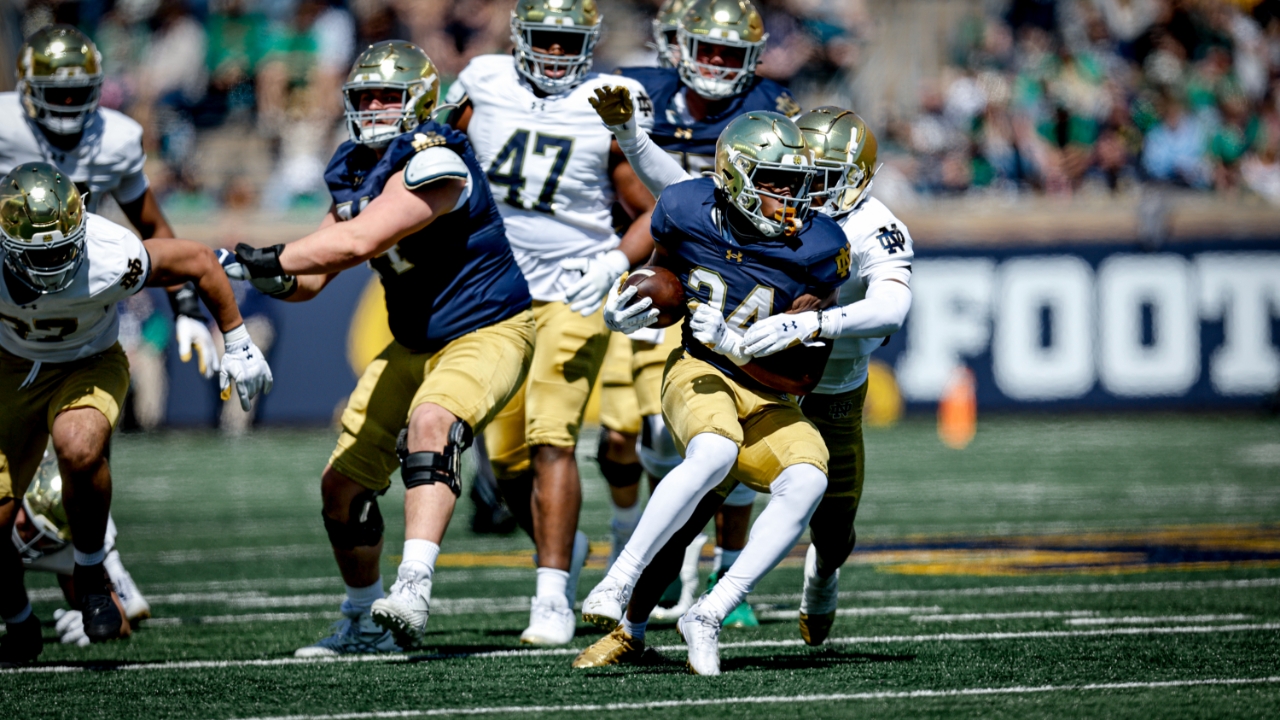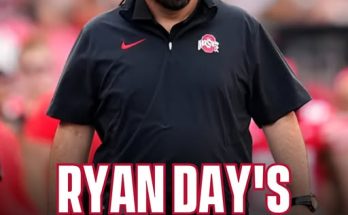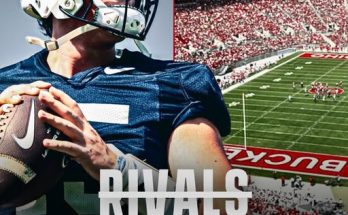The annual Blue-Gold Game isn’t just a scrimmage—it’s a window into Notre Dame football’s soul. A first look at who’s ready, who’s rising, and who’s still a work in progress. This year, all eyes were on the Irish offense. With a new coordinator in Mike Denbrock, fresh faces across the two-deep, and high expectations for 2025, the spotlight was hot and the film was rolling.
And film doesn’t lie.
Denbrock’s return to South Bend brought with it a wave of anticipation. Fans still remember his earlier stint and his recent success at LSU with Jayden Daniels, and hoped he’d bring the same creativity, tempo, and versatility to the Irish. Saturday’s Blue-Gold Game didn’t provide every answer, but it showed enough to paint a clear picture of where things stand—and where things are going.
What stood out first was the tempo. Denbrock didn’t waste any time installing a quickened pace, especially with the first-team unit. While the offense didn’t run at full LSU-style warp speed, the urgency was there. Quarterbacks weren’t huddling often. Pre-snap motion was frequent. And when things were flowing, there was a rhythm to the offense that’s been missing in recent years. The Irish want to move the chains, but they also want to dictate the pace—and that was evident from the jump.
CJ Carr was the biggest name entering the spring game, and the freshman lived up to the buzz. For a player still adjusting to the speed of the college game, Carr looked composed and mature beyond his years. His ball placement was crisp, especially on intermediate routes, and his pocket presence was surprisingly polished. He led multiple scoring drives and showed a strong grasp of Denbrock’s system, making smart decisions and avoiding the classic freshman mistakes. He wasn’t flawless—there were a couple of late reads and a near-pick on a seam route—but Carr looked every bit like the future, and perhaps even the present.
That said, he wasn’t alone in making plays. Kenny Minchey, often the forgotten man in the quarterback room, delivered a solid showing. His arm strength popped on a few sideline throws, and he executed well on rollout concepts. The battle behind Carr for the No. 2 job is real, and Minchey made a case to be taken seriously.
What helped both quarterbacks was a surprisingly stable offensive line. Notre Dame’s tradition of excellence in the trenches didn’t skip a beat. Joe Alt may be gone, but Charles Jagusah looks like the next great bookend. His footwork and ability to reset against edge rushers stood out. Blake Fisher held up well at right tackle, and the interior trio showed strong communication on twists and blitz pickups. The line wasn’t perfect, but the fundamentals were there, and Denbrock’s use of quick game concepts helped neutralize the pass rush.
In the run game, the Irish showed a willingness to rotate backs and test the edges. Jadarian Price flashed again, showcasing his burst and vision on a couple of zone reads and outside runs. He’s a dynamic runner when given space, and Denbrock seems eager to get him involved in the passing game as well. Jeremiyah Love had a quieter day but still contributed solid reps, and early enrollee Aneyas Williams impressed with his low pad level and balance through contact. It’s a deep backfield, and Notre Dame knows it.
The tight ends, always a featured element in South Bend, were active in Denbrock’s system. Holden Staes had the best day of the group, catching several passes over the middle and one in the red zone that showcased his body control and catch radius. Notre Dame leaned into 12 personnel (two tight end sets) more than expected, which could be a sign of things to come. With Staes and Mitchell Evans healthy and involved, Denbrock has the kind of versatile weapons he likes to move around the formation.
But perhaps the most eye-opening development came at wide receiver. For years, Notre Dame has struggled to produce elite playmakers on the outside. That trend may be shifting. Jaden Greathouse, back from an injury-plagued freshman season, looked sharp and confident. He caught a deep ball down the sideline and worked the middle of the field with precision. His route running has clearly improved, and he’s built chemistry with Carr. Tobias Merriweather remains a big target with deep-threat potential, and while his hands have been inconsistent, he hauled in a difficult grab over the middle that showed growth.
True freshman Micah Gilbert might’ve been the biggest surprise. His physicality at the catch point and ability to separate against man coverage jumped off the screen. If he can continue that trajectory, he’ll have a role early. And then there’s Jordan Faison, the dual-sport lacrosse star who continues to carve out a niche with his shiftiness and elite short-area quickness. Denbrock used him creatively—jet motions, quick outs, screens—and it worked. The offense isn’t lacking options at receiver anymore. It’s about finding the right combinations.
Schematically, Denbrock’s influence was clear. He used motion to diagnose coverages and create mismatches. He leaned on RPOs in early downs to keep the defense honest and wasn’t afraid to attack vertically when safeties crept up. One notable wrinkle was the use of empty sets with running backs split wide, forcing linebackers to cover in space. It’s the kind of flexibility that makes the Irish dangerous when fully dialed in.
Red zone execution was a mixed bag. Carr led one clean touchdown drive with quick reads and a sharp throw to Staes in the back of the end zone. But there were also stalls, including one drive that ended in a throwaway and a missed timing route. It’s a reminder that as promising as this offense looks, there’s still a learning curve. Timing, chemistry, and polish will come with reps, but the foundation is in place.
What the film shows, more than anything, is a unit that has bought into a new identity. Last year’s offense often felt disjointed—big plays followed by long lulls, creativity overshadowed by inconsistency. Under Denbrock, the pieces seem to fit better. There’s a clear plan. The quarterbacks are being put in position to succeed. The playmakers are being featured in space. The line is asked to do what it does best: protect and pave the way.
Of course, it’s still spring. The defense wasn’t throwing exotic looks. The pass rush was controlled. And there were no live bullets. But within the limitations of the format, Notre Dame’s offense delivered a message: It’s evolving, it’s dynamic, and it’s ready to turn the page.
The coming months will be crucial. Carr needs to keep stacking good days and prove he can handle the pressure when the real games start. The wideouts need to stay healthy and continue developing chemistry. The offensive line must build cohesion and depth. But make no mistake—there’s real potential here. Denbrock’s system has the structure and flexibility to be elite, and the talent on the roster is better than it’s been in years.
For a fanbase hungry for offensive fireworks to match its defensive prowess, Saturday’s Blue-Gold Game was a welcome appetizer. The film doesn’t promise perfection. But it does promise promise. And in South Bend, that’s more than enough to believe in.



